
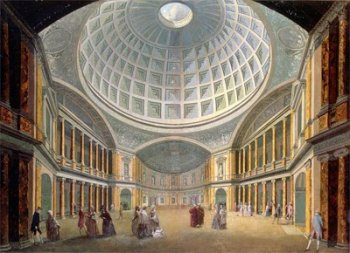 Ancient Rome pushed engineering to great heights with the innovations of new technologies. They introduced unprecedented cities, culture, and design. These innovations were lost from the world for over a thousand years when Rome fell. But they were rediscovered, and today we continue to build on their ideas.
Ancient Rome pushed engineering to great heights with the innovations of new technologies. They introduced unprecedented cities, culture, and design. These innovations were lost from the world for over a thousand years when Rome fell. But they were rediscovered, and today we continue to build on their ideas.
Dome
Domes had been around a long time before Rome. There were two kinds. The Tholos was an underground domed tomb with stacked concentric slabs of stone. The Tumulus mound was a rough construction of stones. The Romes vastly increased the size of domes. The Pantheon is still the largest unreinforced concrete dome in the world.Rome likewise vastly increased the scale of the barrel vault, which had been used in Sumeria and Egypt for many years. Romans increased the height of structures by placing arches atop columns. They also strengthened their structures by using groin vaults at the intersection of two barrel vaults.
War Machines
Rome greatly expanded its empire through the use of engineering. The praefectus fabrum were in charge of war machines and war structures, such as Hadrian’s Wall which crossed the whole of Britain.
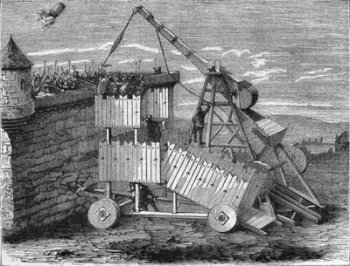 Roman engineers invented or developed a variety of siege machines: Tormenta, ballistae, testudo, gallery, onager, scorpios, battering ram, siege tower, mine. A large portion of Ten Books on Architecture by Vitruvius is devoted to engineering in offensive and defensive positions.
Roman engineers invented or developed a variety of siege machines: Tormenta, ballistae, testudo, gallery, onager, scorpios, battering ram, siege tower, mine. A large portion of Ten Books on Architecture by Vitruvius is devoted to engineering in offensive and defensive positions.
Concrete
Concrete was developed around 250 B.C. based on ancient Mesopotamian recipes. After the burning of Rome in 64 AD, concrete is used extensively in reconstruction of the city structures. Its versatility and structural properties made concrete a good material for the area. Many structures that may appear to be stone are actually concrete.
The recipe for pozzolan cement was lost in 476 AD upon the fall of Rome. This was a major contributing factor in Europe’s Dark Age.
Roads & Bridges
Key to Rome’s success was their system of roads and bridges across the land. They allowed quick troop movement, trade, and communication. Major roads connected cities and were stone-paved, curved for drainage, and flanked by sidewalks and ditches. Survey teams engineered these roads to be comfortably level through mountains and marshes.
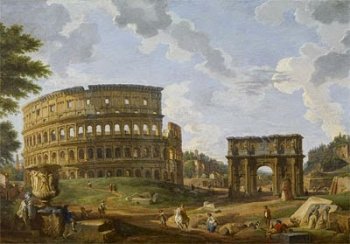 As part of this network, Romans built great bridges. Concrete and arch technology allowed them to build robust bridges larger than ever before.
As part of this network, Romans built great bridges. Concrete and arch technology allowed them to build robust bridges larger than ever before.
Sewers
Health was a major consideration for Roman design. Vitruvius discussed the drainage of wetlands and testing of site conditions as the first step in building a city.
Rome established a system of drainage, as it was originally a marshland. The Etruscans were among the first to drain rainwater to avoid erosion. These drain paths eventually served to dispose of human waste, and these channels were covered to form a sewer. Water from the public baths were reused at public latrines, and upper-class home connected directly to the sewer. Knowledge of the sewer was lost when Rome fell.
Baths
As part of their emphasis on health, Romans constructed public bath utilities. The thermae were devoted to bodily and mental health, with libraries, classrooms, and exercise gymnasiums included.
The hypocaust system was an efficient heating system that pumped heated air under floors. Floors were raised and rooms arranged to make optimal use of the heated air. This system is the basis of some heating strategies today.
Aqueducts
Engineers went to great lengths to pump water to their cities. Though many ancient nations achieved incredible aqueducts, the Roman aqueducts are noteworthy because of their precision. The chorobate was used to keep the water channel’s slope very slight. Reservoirs were created to feed the aqueducts, though standing water was avoided due to the health affects.
The stacked Roman arch made it possible to cross rivers and wide valleys. Careful design went into the material, shape, and scale of these aqueducts for optimal construction.
Social Projects
The government of ancient Rome subsidized basic costs for the general population such as education and food. Perhaps the most important social projects were structures, however. The forum, the circus, the coliseum, baths, etc. were public venues that used architecture’s unique role in social relations.
Vitruvius spoke of architecture in terms of social responsibility, terms that are rarely heard today. We may talk about environmental concerns and community, but social responsibility may be the one innovation we haven’t truly gotten back.
Source: www.architecturerevived.com
RELATED VIDEO
10 Ancient Architectural Achievements - History and Headlines
Ancient Greek and Roman Achievements

 Ancient Rome pushed engineering to great heights with the innovations of new technologies. They introduced unprecedented cities, culture, and design. These innovations were lost from the world for over a thousand years when Rome fell. But they were rediscovered, and today we continue to build on their ideas.
Ancient Rome pushed engineering to great heights with the innovations of new technologies. They introduced unprecedented cities, culture, and design. These innovations were lost from the world for over a thousand years when Rome fell. But they were rediscovered, and today we continue to build on their ideas.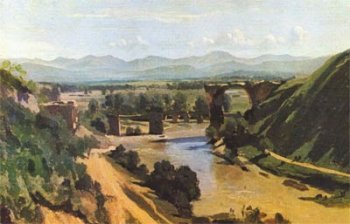
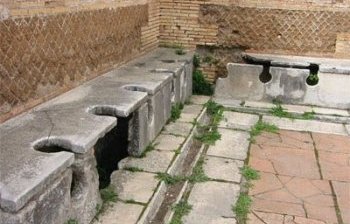
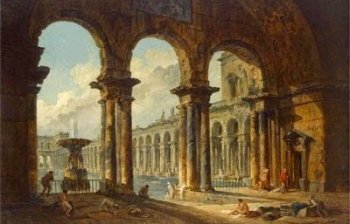
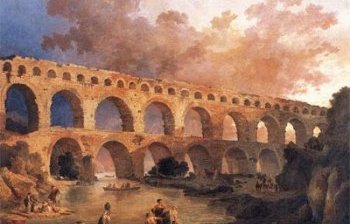



 Roman engineers invented or developed a variety of siege machines: Tormenta, ballistae, testudo, gallery, onager, scorpios, battering ram, siege tower, mine. A large portion of Ten Books on Architecture by Vitruvius is devoted to engineering in offensive and defensive positions.
Roman engineers invented or developed a variety of siege machines: Tormenta, ballistae, testudo, gallery, onager, scorpios, battering ram, siege tower, mine. A large portion of Ten Books on Architecture by Vitruvius is devoted to engineering in offensive and defensive positions. As part of this network, Romans built great bridges. Concrete and arch technology allowed them to build robust bridges larger than ever before.
As part of this network, Romans built great bridges. Concrete and arch technology allowed them to build robust bridges larger than ever before.







